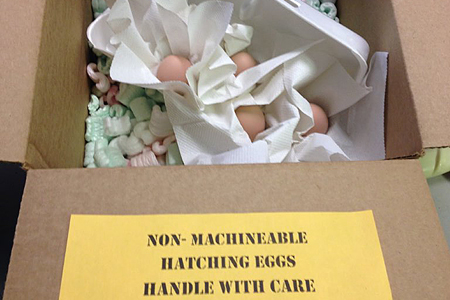
Eggs that are sold specifically for hatching are called, fittingly enough, hatching eggs. They cost more than eating eggs but come with no guarantee they will hatch. Too many variables are not under the seller’s control. Even eggs laid by your own hens, or otherwise sourced locally, are not guaranteed to hatch. But when hatching eggs are shipped by mail, all sorts of additional factors influence their rate of hatch.
Shipping Issues
Eggs that are shipped by mail can encounter any number of different problems that will affect their hatchability. Here are some of the more common issues:
- Being subjected to excessive summer heat or winter freezing, either of which can weaken or kill embryos.
- Remaining in transit too long. Delayed shipping that results in a lapse of more than 10 days from the time the eggs are laid to the start of incubation will reduce the hatching rate.
- Rough handling — including such things as tumbling off a mail sorter or bouncing around in a delivery vehicle — can scramble the eggs and damage the shell membrane, or even crack the shells.
“Once hatching eggs leave our facility, we cannot guarantee how they will be handled in transit,” says Jeff Smith of Cackle Hachery®. “We do, however, include a delivery receipt for egg shipments. So you need to be available to sign the receipt when the eggs are delivered.
“Before signing, open the box to see if any eggs are broken. If so, please note it on the delivery receipt and call us within 24 hours. For visibly damaged eggs, we offer a one-time reshipment. After the one-time reshipment we can no longer replace or refund. Customers order hatching eggs at their own risk and rely on the postal service for safe delivery.”
Incubation Issues
Another thing the hatchery had no control over is how the eggs are incubated. If they are to be hatched under a hen, is the hen a reliably good setter? If they are hatched in an incubator, is the incubator properly set up and operated?
“An incubator should be turned on several weeks before the eggs arrive and checked out to make sure it is regulated and runs properly for at least 2 days,” Smith recommends.
Fertility Issues
The term “fertile hatching eggs” does not mean all the eggs will hatch. It doesn’t even mean that every egg is fertile. It means that the hens that laid the eggs are housed with roosters, with the expectation that the roosters will fertilize the hens’ eggs. Low fertility occurs for many different reasons, some of which have to do with breeds and bloodlines.
“Based on each breed, we use an appropriate ratio of males to hens, both of optimal age for fertility,” Smith explains. “Still, some breeds by nature hatch at a rate of only 50%, while others typically have a hatch rate as high as 95%.”
Improving Your Odds
Eggs that are shipped by mail, or held longer than 10 days before being incubated, experience reduced hatchability of 60% on average. So for eggs with a typical hatch rate of 70%, expect about 42% to hatch if the same eggs are shipped by mail.
Two things can be done to improve the hatching rate of shipped eggs. When the eggs arrive, do not attempt to clean them. The eggs don’t need to be spotless, and trying to clean them may drive bacteria through the protective shell.
Do, however, allow the eggs time to settle before placing them in your incubator or under your hen. Settling gives the eggs a rest after being jostled during transport and also gives them time to adjust to a uniform temperature before incubation begins. Let the eggs settle for at least half a day, but no more than 2 days. Place them away from sunlight, where the temperature is between 50 and 60°F and the humidity is between 70 and 80%.
Eggs shipped by mail are highly unlikely to hatch at the same rate as fresher eggs that are not subjected to the rigors of transport. But settling them before incubation should improve the hatch rate, compared to eggs that have not been settled.
And that’s today’s news from the Cackle Coop.
Gail Damerow is the author of Hatching and Brooding Your Own Chicks


In reference to the shipping delay, which I’m experiencing right now. Maybe you could offer the client the option for next day shipping, two day shipping, and additional insurance. Which I would have bought both. My egg order was extremely expensive, and for good reason. I would have liked to have had the option to protect it more.